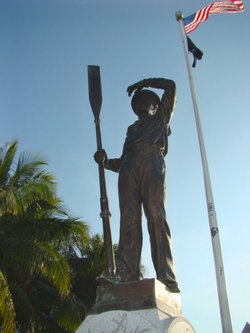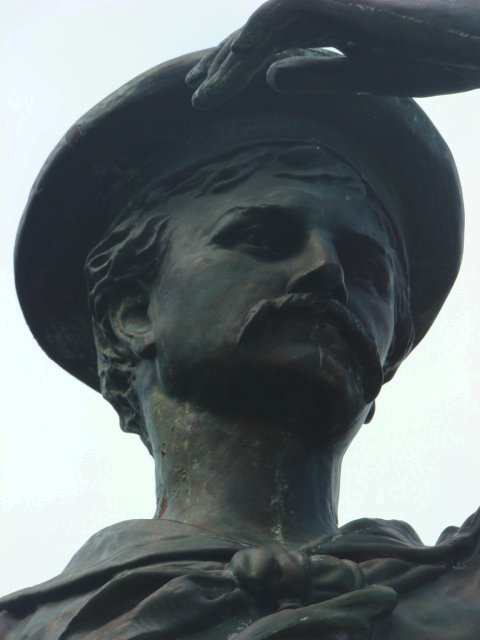___________________________________________
The Maine spent her active career operating along the East Coast of the United States and the Caribbean. In January 1898, the Maine was sent from Key West, Florida, to Havana, Cuba, to protect U.S. interests during a time of local insurrection and civil disturbances. Three weeks later, at 9:40 on the night of February 15, an explosion on board the Maine occurred in the Havana Harbor. Later investigations revealed that more than five tons of powder charges for the vessel's six and ten-inch (254 mm) guns had ignited, virtually obliterating the forward third of the ship. The remaining wreckage rapidly settled to the bottom of the harbor. Most of the Maine's crew were sleeping or resting in the enlisted quarters in the forward part of the ship when the explosion occurred. Two hundred and sixty-six men lost their lives as a result of the explosion or shortly thereafter, and eight more died later from injuries. Captain Charles Sigsbee and most of the officers survived because their quarters were in the aft portion of the ship. On March 28, the US Naval Court of Inquiry in Key West declared that a naval mine caused the explosion.
The explosion was a precipitating cause of the Spanish-American War that began in April 1898 and which used the rallying cry, "Remember the Maine!, To hell with Spain!"
The episode focused national attention on the crisis in Cuba but was not cited by the William McKinley administration as a casus belli, though it was cited by some who were already inclined to go to war with Spain over their perceived atrocities and loss of control in Cuba.
___________________________________________
Memorials
___________________________________________
Memorial at Arlington National Cemetery In February of 1898, the recovered bodies of sailors who died on the American Battleship Maine were interred in the Colon Cemetery, Havana. Some injured sailors were sent to hospitals in Havana and Key West. Those who died in hospitals were buried in Key West. In December of 1899 the bodies in Havana were disinterred and brought back to the United States for burial at Arlington National Cemetery where there is a memorial to those who died and which includes the ship's main mast. Some bodies were never recovered and the crewmen buried in Key West remain there under a statue of a U.S. sailor holding an oar. There is also a memorial, consisting of the shield and scrollwork from the bow of the ship, in Bangor, Maine. Shells from the main battery were placed along with small plaques as memorials at the Soldier's Home in Marion, Indiana (now a VA Hospital and national cemetery) and at the St. Joseph County Courthouse lawn in South Bend, Indiana. The base of the Maine's conning tower is currently on display at Westbrook Veterans' Memorial Park in Canton, Ohio, hometown of President McKinley. A shell from the main battery is located just inside of the Pine St. entrance of city hall in Lewiston, Maine. The explosion-bent fore mast of the Maine is located at the United States Naval Academy at Annapolis, Maryland. There is a monument for the Maine and a portion of a bronze engine room ventilator shaft from the Maine in Pompton Lakes, New Jersey. There is a traditional in-joke among midshipmen at the Academy that the Maine, with its main mast in Eastern Virginia and its fore mast in Central Maryland, is the longest ship in the Navy.
___________________________________________
On August 5, 1910, Congress authorized the raising of the Maine to remove it as a navigation hazard in Havana Harbor. On February 2, 1912, she was refloated under supervision of the Army Corps of Engineers and towed out to sea where she was sunk in deep water in the Gulf of Mexico on March 16, 1912, with appropriate military honors and ceremonies.
___________________________________________
The Maine spent her active career operating along the East Coast of the United States and the Caribbean. In January 1898, the Maine was sent from Key West, Florida, to Havana, Cuba, to protect U.S. interests during a time of local insurrection and civil disturbances. Three weeks later, at 9:40 on the night of February 15, an explosion on board the Maine occurred in the Havana Harbor. Later investigations revealed that more than five tons of powder charges for the vessel's six and ten-inch (254 mm) guns had ignited, virtually obliterating the forward third of the ship. The remaining wreckage rapidly settled to the bottom of the harbor. Most of the Maine's crew were sleeping or resting in the enlisted quarters in the forward part of the ship when the explosion occurred. Two hundred and sixty-six men lost their lives as a result of the explosion or shortly thereafter, and eight more died later from injuries. Captain Charles Sigsbee and most of the officers survived because their quarters were in the aft portion of the ship. On March 28, the US Naval Court of Inquiry in Key West declared that a naval mine caused the explosion.
The explosion was a precipitating cause of the Spanish-American War that began in April 1898 and which used the rallying cry, "Remember the Maine!, To hell with Spain!"
The episode focused national attention on the crisis in Cuba but was not cited by the William McKinley administration as a casus belli, though it was cited by some who were already inclined to go to war with Spain over their perceived atrocities and loss of control in Cuba.
___________________________________________
Memorials
___________________________________________
Memorial at Arlington National Cemetery In February of 1898, the recovered bodies of sailors who died on the American Battleship Maine were interred in the Colon Cemetery, Havana. Some injured sailors were sent to hospitals in Havana and Key West. Those who died in hospitals were buried in Key West. In December of 1899 the bodies in Havana were disinterred and brought back to the United States for burial at Arlington National Cemetery where there is a memorial to those who died and which includes the ship's main mast. Some bodies were never recovered and the crewmen buried in Key West remain there under a statue of a U.S. sailor holding an oar. There is also a memorial, consisting of the shield and scrollwork from the bow of the ship, in Bangor, Maine. Shells from the main battery were placed along with small plaques as memorials at the Soldier's Home in Marion, Indiana (now a VA Hospital and national cemetery) and at the St. Joseph County Courthouse lawn in South Bend, Indiana. The base of the Maine's conning tower is currently on display at Westbrook Veterans' Memorial Park in Canton, Ohio, hometown of President McKinley. A shell from the main battery is located just inside of the Pine St. entrance of city hall in Lewiston, Maine. The explosion-bent fore mast of the Maine is located at the United States Naval Academy at Annapolis, Maryland. There is a monument for the Maine and a portion of a bronze engine room ventilator shaft from the Maine in Pompton Lakes, New Jersey. There is a traditional in-joke among midshipmen at the Academy that the Maine, with its main mast in Eastern Virginia and its fore mast in Central Maryland, is the longest ship in the Navy.
___________________________________________
On August 5, 1910, Congress authorized the raising of the Maine to remove it as a navigation hazard in Havana Harbor. On February 2, 1912, she was refloated under supervision of the Army Corps of Engineers and towed out to sea where she was sunk in deep water in the Gulf of Mexico on March 16, 1912, with appropriate military honors and ceremonies.
Advertisement
Explore more
Sponsored by Ancestry
Advertisement




